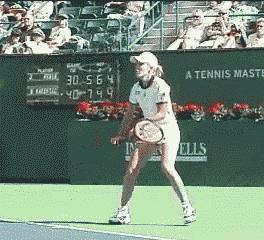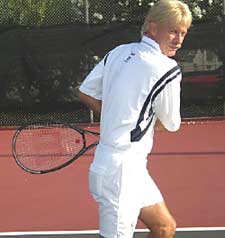|
TennisOne Lessons
One-Hands or Two Hands?One-Handed Backhand—Pros
One-Handed Backhand—Cons
Two-Handed Backhand—Pros
Two-Handed Backhand—Cons
Executing the One-Handed BackhandStarting in a neutral ready-position, cradle the throat of the racquet with the non-hitting hand. As the ball bounces on the opponent’s side or as he begins his swing to strike the ball, execute your split step. As you determine the direction of the ball, adjust your grip to the appropriate position with the non-hitting hand. Begin the unit turn. Allow your front or lead shoulder to rotate taking
the racquet back for you. Take small adjusting steps to position
your body to the ball. The ideal position is with the left foot behind the
ball and bearing your weight. Your eyes remain quietly focused on the
in-coming ball as you prepare to bring the racquet out of your non-hitting
hand with your right hand (right-handed players) to meet the ball at the
appropriate point of contact and direct the ball toward the intended
target. After contact, allow the racquet to continue its path toward the
intended target into the follow-thru position higher than the front or
hitting shoulder for a topspin drive. The Two-Handed BackhandThe ready position for the two-hander is similar to that of the one-handed backhand: the non-hitting hand balancing the racquet, with the racquet hitting hand relaxed to adjust to a forehand or backhand grip based upon the return by the opponent.
Execute the split step the same as you would for the one-hander, as the ball bounces on the opponent’s side or as he begins his swing to strike the ball. As you read the direction of the ball, select your backhand grip or continental grip with the hitting hand and turn your left foot away from the body. This will initiate the upper body rotation so that the front or right shoulder will point in the direction of the in-coming ball. Allow your feet to continue to adjust so that it is in the left foot lines up behind the in-coming ball. As your eyes track the ball, begin to move your left knee, left hip, and left hand toward the approaching ball. Allow your weight to begin to shift forward from the left foot to the right. Your hands remain relaxed, with the left hand with the left hand helping to determine the direction of the shot you are to make. At the point of contact, the racquet momentum allows the hands to move toward the intended target as the follow-through continues up and forward over the right shoulder. Your weight now transferred will begin to return to a neutral position (in the middle of the possible return angles from his opponent), the right hand relaxed, the feet moving, the eyes still tracking the ball in flight toward your opponent’s racquet. Open and Closed StanceEither backhand may be hit with an open or closed stance. At the professional level, you’re seeing more players hit with the open stance. The open stance has the advantage of cutting down setup and recovery time, an aggressive style that is well suited for the fast paced, high powered style of professional tennis. However, that doesn't mean the pros have completely abandoned the closed stance. When an Agassi or a Kafelnikov gets a chance to move into the court on a shorter ball, you’ll often see them hit with a closed stance.
A closed stance allows players moving forward to transfer their weight into the ball better than can be accomplished with an open stance. In the open stance, the player has to rely more on angular momentum, or the rotating or turning motion to generate power on deep or excessively wide shots. Which setup should the club player use? I would say it depends once again upon the depth and pace of the shot that comes from your opponent. If the ball is hit fast and deep, you’re probably going to have to use an open stance, as you won’t have time for a closed setup. However, if the ball is short, move in aggressively and hit that backhand with a closed stance. The Racquet Take-BackHow far should you take the racquet back depends on how well you execute your body turn. Typically, if you were looking directly across the net at a player hitting a backhand, you probably wouldn’t see the racquet on the backswing on the other side of the player’s body. There are exceptions of course. When Serena Williams, for example, has time to setup for backhand, sometimes you’ll see the racquet on the far side of her body as she exaggerates her unit-turn. At the same time, this large take-back can introduce more errors, and certainly Serena has suffered at times from generating too many unforced errors (although not necessarily for this reason alone).
A common error at the club level is for players to take their racquet back further than their unit-turn would justify. This creates a different swing path (more around the body) and tends to generate a wristy shot. The Swing PathIn the take-back motion, the movement of the hands should be achieved
as part of the unit turn. The racquet stays in front of the body as you
turn. If you were to trace the motion path of the racquet head it would
resemble a loop or semi-loop, high on the take-back, dropping down as you
turn and hit through the ball and then finishing high over the shoulder.
How Low Should You Go?Two things surprise may you when you watch a professional tennis match. First, see how high over the net most shots are hit. Whenever possible, the pros give themselves a substantial margin of error over the net.
Secondly, notice how low to the ground the pros are able to get when lining up their shots. They’re able to do this because of their superior flexibility and balance, and from this low coil, they are more able to explode forward and up into the shot. In fact, the pros generate so much upward momentum into their shots that their feet leave the ground during the hit and follow-through. How low should the average club player go? I would say as low as you naturally get. Remember, power begins from the ground up. That’s why it’s important to work on your fitness and flexibility: the more range of motion you have, the more power you can generate. Tactical ConsiderationsCross-Court or Down the Line?If the direction of your opponent’s ball crosses the line of your body,
generally the most consistent shot is to return the ball back in the same
direction (cross-court), as it’s difficult to change the direction (angle
of reflection) to go down the line on a ball hit deep to you. This
principle comes from Paul Wardlaws’ High Percentage Tennis. (The exception
is when receiving a short ball or a very slowly hit ball, and you have
more time to move forward into your shot).
Slice or Drive?Whether you slice or drive the ball often depends on how much time you have or your choice of tactics. At the professional level, you see a higher percentage of driving topspin shots, as the pros setup early and are more aggressive. At the same time, more and more pros are using the slice to neutralize a point or when they need more time on a difficult shot. At the club level, players often don’t prepare early enough, which is why I recommend that club players use a slice about 40 percent of the time. The slice is a neutralizing shot, allowing the player to negate the opponent’s offensive, change the spin of the ball, and get the rally back to neutral. Of course anytime you have a chance to hurt your opponent or put pressure on him, the topspin drive is your most effective weapon. Wrap-UpIn watching the pros, we are more likely to notice the shot that won
the point rather than the shots that led the pro to be in the position to
win the point. These set-up shots are what we really need to develop. The slice can also help you offensively, allowing you to take a short ball and come into net behind a low-bouncing slice approach shot. Your opponent then has to hit up, putting you in position to win the point with your volley. Does this mean you should favor a slice backhand? Not at all. When you have the time and opportunity, use your driving backhand to put pressure on your opponent. The bottom line, then, is that club players should master both the drive and slice backhand, so they can adapt to more match play situations and adjust to different playing styles. The more options the better.
|
To contact us, please email to: webmaster@tennisone.com TennisONE is a registered trademark of TennisONE and SportsWeb ONE; Copyright 1995. All rights reserved. |
||||||||||||||||








